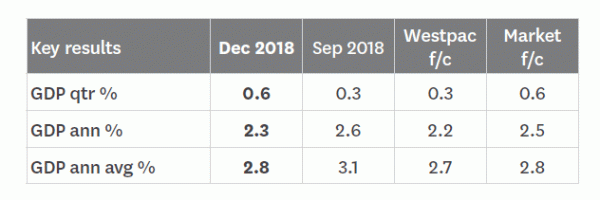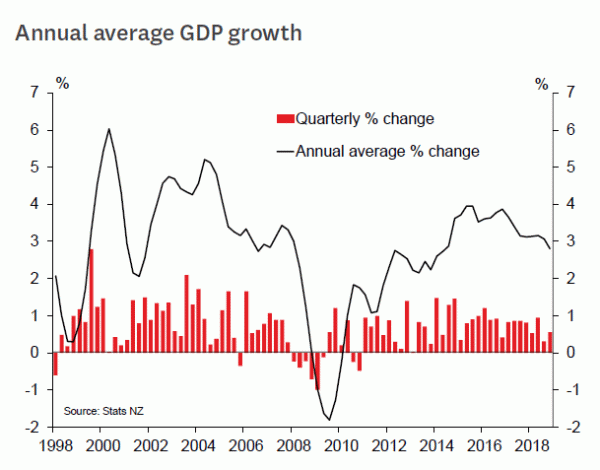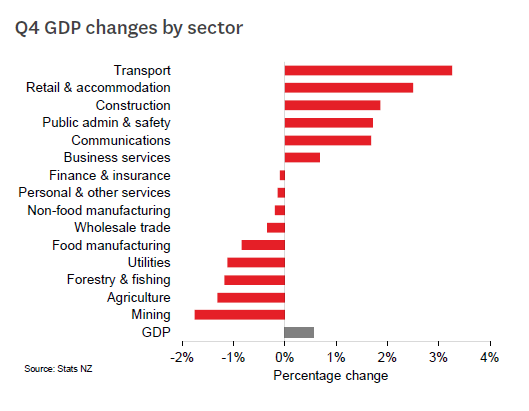- GDP rose by 0.6% in the December quarter, a stronger rebound than we expected after a weak 0.3% rise in September.
- Household spending and construction were highlights for the quarter, while personal and business services were mixed. Energy sector disruptions were a temporary drag on growth.
- Today’s results give us more comfort around our view that growth will regain some momentum over 2019.
- Growth was a little below the Reserve Bank’s forecast, but not enough to warrant a change of tone in next week’s OCR review.
New Zealand’s GDP rose by 0.6% in the December quarter, a result that was stronger than we expected but was in line with market forecasts. Growth for the year as a whole slowed to 2.8%, slipping below the 3% mark for the first time since September 2014.
Today’s GDP figures come as something of a relief. It’s clear that the economy lost some momentum over the second half of last year – just not as much as we thought, and in particular the weak 0.3% gain in the September quarter looks to have understated the true picture. That gives us a bit more comfort about our view that the pace of growth will pick up again in 2019, with support from government spending, construction, and rising household incomes.
The results also provide some food for thought ahead of next Wednesday’s Reserve Bank OCR review. Previously we’d said that the RBNZ was ‘preloaded’ for a dovish shift in its language in March, given the downside risks that were already apparent at the February Monetary Policy Statement. But that’s no longer shaping up to be the case. GDP was only modestly below the RBNZ’s forecast of 0.8%, and other recent developments – softer house prices, stronger commodity prices – have been more balanced. It seems more likely now that the RBNZ will hold its line in next week’s statement.
The GDP figures are even more of a challenge to financial markets, which have gone beyond anticipating a change of tone from the RBNZ and have been pricing in the possibility of OCR cuts over the next year. There certainly has been a dovish shift among central banks around the world in recent months. But ultimately the RBNZ sets monetary policy based on local conditions, not what the rest of the pack is doing. There just isn’t a strong case for interest rate cuts in an economy that is trundling along at about its potential.
Details
The production measure of GDP rose by 0.6%, following a 0.3% increase in the September quarter. There were some minor revisions to previous quarters, which affected the annual growth rate a little but made no real difference to the level of GDP.
As expected, strong gains in retail spending (up 2.5%) and construction (up 1.8%) were among the highlights for the quarter. Government services (up 1.8%) and healthcare (up 0.9%) also made solid contributions.
Relative to our forecast, the main surprise was a strong rebound in transport (up 3.2%) and communications (up 1.6%). Both of these sectors were surprisingly soft in the September quarter, and we expected some rebound this time – it just proved to be even larger than we anticipated.
On the weaker side, the disruptions in the energy sector over the quarter were apparent. Supply disruptions from the Pohokura gas field weighed on mining, chemical manufacturing and electricity generation. The latter was also affected by low hydro lake levels during the quarter. These disruptions will eventually disappear, although the Pohokura field saw a further maintenance shutdown during the March quarter.
Growth in the service sectors was mixed. As mentioned above, retail, transport and healthcare saw strong gains. But there were declines in finance, wholesaling, recreation and personal services. Real estate services recorded strong growth in both of the last two quarters, though that seems out of step with house sales which were broadly flat over that time.
The expenditure measure of GDP rose by 0.5%. While this measure is considered less reliable on a quarterly basis, it perhaps sheds more light on the nature of the slowdown in growth over the second half of last year.
Household spending has continued to grow at a robust pace, supported by Government transfers from the Families Package and rising household incomes. Spending was boosted further by the easing in petrol prices during the December quarter. Construction activity grew modestly, though it’s likely that capacity constraints have been an ongoing factor.
In contrast, the slowdown has largely been a business-led one. Investment in capital equipment rose strongly over 2017, but more or less flatlined over 2018. This may be a delayed reflection of low business confidence after the change of government in late 2017; if so, we don’t expect it to be a lasting drag on activity.
The growth slowdown also partly reflects the fact that government consumption hasn’t stepped up in the way that we would have expected, given the fiscal projections. We still expect spending to ramp up as planned, and that plays an important role in our forecasts of GDP growth for the next couple of years.
















